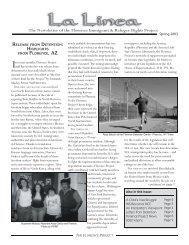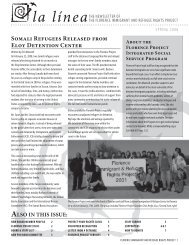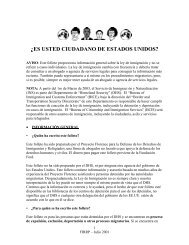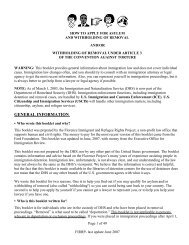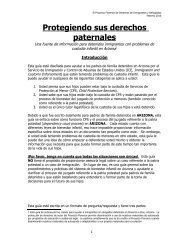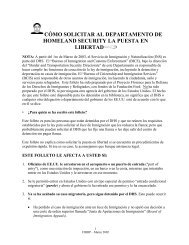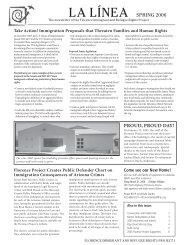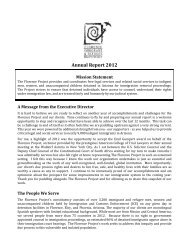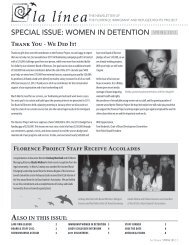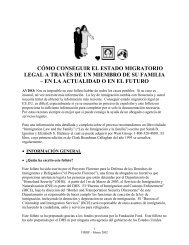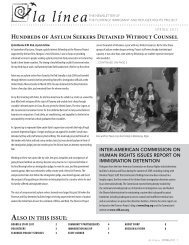quick reference chart and annotations for determining immigration ...
quick reference chart and annotations for determining immigration ...
quick reference chart and annotations for determining immigration ...
Create successful ePaper yourself
Turn your PDF publications into a flip-book with our unique Google optimized e-Paper software.
Immigrant Legal Resource Center, Florence Immigrant <strong>and</strong> Refugee Rights Project,<br />
Maricopa County Public Defender August 2012<br />
crime of child abuse even though no proof of actual harm or injury to the child is required). However,<br />
Matter of Soram may be in conflict with the Ninth Circuit’s decision in Pacheco-Fregozo v. Holder, 576<br />
F.3d 1030 (9th Cir. 2009), which held that a statute that includes only the possibility of harm, with no<br />
actual physical or emotional injury, does not categorically fall within the definition of a “crime of child<br />
abuse.” See Jimenez-Juarez v. Holder, 635 F.3d 1169, n.2 (9th Cir. 2011) (upholding Pacheco-Fregozo<br />
post-Soram). Defense counsel should conservatively advise that any plea to A6 will be removable as a<br />
crime of child abuse but attempt to plead to language that avoids any <strong>reference</strong> to actual harm or injury to<br />
the victim.<br />
Other Grounds: Firearms. Where firearms is an element of the statute (e.g., A9(a)), or where a<br />
weapon is an element <strong>and</strong> the record of conviction identifies the weapon as a firearm (e.g., A2), the<br />
offense will cause deportability under the firearms ground. See Note: Firearms.<br />
13. Unlawfully Administering Intoxicating Liquors, Narcotic Drugs or Dangerous Drugs, ARS §<br />
13-1205<br />
A person commits unlawfully administering intoxicating liquors, a narcotic drug or dangerous drug if, <strong>for</strong><br />
a purpose other than lawful medical or therapeutic treatment, such person knowingly introduces or causes<br />
to be introduced into the body of another person, without such person’s consent, intoxicating liquors, a<br />
narcotic drug or dangerous drug. This is a class 6 felony, except it is a class 5 felony if the victim is a<br />
minor.<br />
This may be a useful alternate to a sexual offense or drug crime.<br />
Crime Involving Moral Turpitude (CMT): Assume yes, although no case law on point.<br />
Aggravated Felony: Not as a drug offense; administration of drugs does not appear as a federal<br />
controlled substance offense. Conceivably DHS would charge it as a crime of violence, as an offense that<br />
is likely to lead to use of <strong>for</strong>ce, so avoid 365 day sentence.<br />
Other Grounds: Controlled Substance: This conviction will make a person deportable <strong>and</strong><br />
inadmissible as a controlled substance offense only if the record of conviction specifies that the offense<br />
involved a drug, rather than alcohol. Defense counsel should plead to alcohol or at least leave the record<br />
vague between alcohol <strong>and</strong> controlled substances.<br />
In theory, a conviction is only removable as a controlled substance offense if the drug is<br />
identified as a federally recognized controlled substance in the record of conviction. However, some<br />
unpublished BIA decisions have held that, even though the Arizona controlled substance schedule<br />
contains drugs that do not appear on the federal schedule, the Arizona legislature “intended to” track the<br />
federal list of illegal drugs such that an Arizona drug conviction is removable regardless of whether a<br />
controlled substance is identified. See In Re: Ramon Roberto Huerta-Flores A.K.A. Roberto Huerta, :<br />
A092 444 014 - ELO, 2010 WL 5808899 (BIA Aug. 27, 2010). There<strong>for</strong>e, counsel should try to leave<br />
the record vague as to what controlled substance was involved but should not assume that a controlled<br />
substance conviction with an unidentified drug will be safe.<br />
14. Dangerous or deadly assault by prisoner or juvenile, ARS § 13-1206<br />
A person, while in the custody of the state department of corrections, the department of juvenile<br />
corrections, a law en<strong>for</strong>cement agency or a county or city jail, who commits an assault involving the<br />
Arizona Criminal Chart with Explanatory Endnote – August 2012<br />
27



